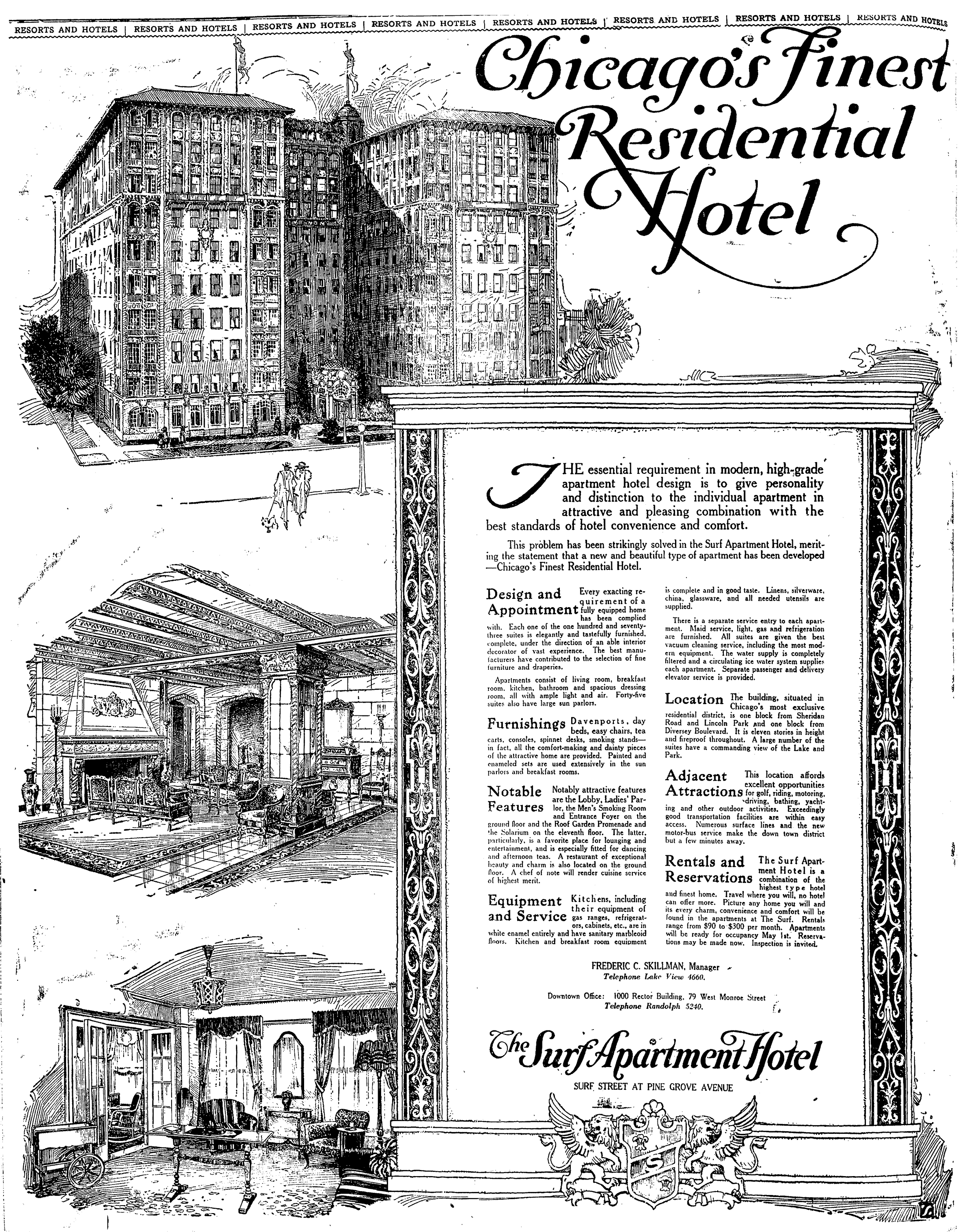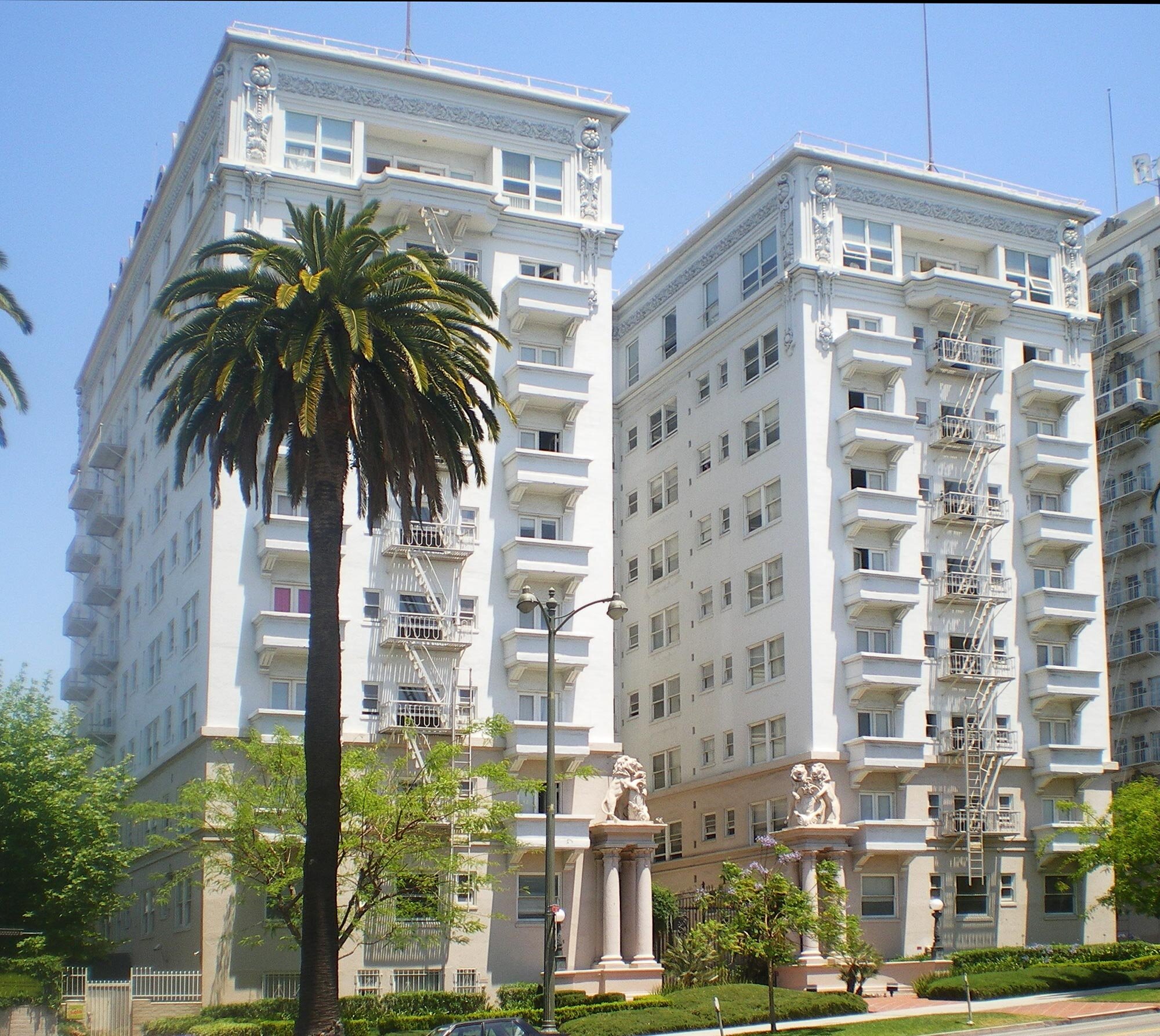The 1915 Kellshore Apartment Hotel, 718-756 W. Irving Park Road. Photo by Julia Bachrach.
Kellshore Hotel entryway. Photo by Julia Bachrach
Over the last few months, I’ve been writing about lesser known architects in Chicago history, many of whom participated in a major building boom of the 1910s and 1920s. For this and next month’s postings, I’ve decided to explore an interesting building type of that era—the apartment hotel. Although residential hotels had existed in Chicago during the late 19th century, a few decades later, a new version of the building type became popular throughout the city—especially with middle-class tenants who needed to stretch their budgets. According to a 1919 article in Buildings and Building Management, these dwellings combined “the advantages of a hotel and a high-grade apartment building,” while eliminating “the bad features.”
Display ad for the Surf Apartment Hotel, Chicago Tribune, April 14, 1918.
The 1918 Surf Apartment Hotel at 501 W. Surf Street is now a senior housing facility known as Britton Budd Apartments. Photo by Julia Bachrach.
The new market for apartment hotels provided opportunities for numerous local architects, many of whom could be considered “lesser known” today. While the buildings ranged in size and style, they represented an attempt to provide elegant living spaces with an array of amenities at affordable prices. The development of this new generation of apartment hotels can be thought of as a byproduct of the nascent national obsession with automobiles. As growing numbers of middle-class Americans purchased cars, tourism began to surge, and travelers wanted accommodations that were homier and less expensive than hotels.
Robert Carroll Cash, an employee of Albert Pick & Co., a manufacturer of hotel and restaurant ware, wrote several publications about the emergence and rapid spread of apartment hotels throughout America. In an article Carroll authored for Hotel World magazine in 1917, he explained that the nation’s first apartment hotels had been built in California more than a decade earlier. At the time of his publication, he asserted, thousands of apartment hotels had already opened along the Pacific Coast and they were now “spreading all over the country.”
The Bryson Apartments, Los Angeles. From “Apartment Hotels— Present and Future,” by Walter W. Ahlschlager, Hotel World, November 3, 1917.
Though travelers had spurred the development of these buildings, apartment hotels appealed to both short- and longer-term residents. The November 3, 1917 volume of Hotel World also included an article by Walter W. Ahlschlager (1867-1967), a Chicago architect who later produced such noteworthy structures as the Medinah Athletic Club at 505 N. Michigan Avenue. In his essay, Ahlschlager referred to the Bryson Apartments in Los Angeles as a nationally influential model. He suggested that the building’s owner, “a pioneer in the apartment hotel field,” had made good returns on a smaller, earlier apartment hotel in L.A., and so had “no hesitancy in ‘going the limit’,” to make the 1913 Bryson the latest word “in modern housekeeping efficiency.”
Bryson Apartment Hotel, 2701 Wilshire Boulevard, L.A. Courtesy of Wikicommons.
Ahlschlager suggested that the location of an apartment hotel was of vital importance to its success. He wrote that “a corner is decidedly preferable to an inside lot,” and also explained that an apartment hotel facing a beautiful park could bring in rents totaling 10% more than those of a similar building on “an unimportant narrow street.” Ahlshlager designed Chicago’s Cambridge Apartment Hotel, which opened in 1916 at the corner of W. Diversey Parkway and N. Cambridge Avenue. Although not located directly across from Lincoln Park, the structure stood only two blocks away.
Left: Cambridge Apartment Hotel from Modern Apartment Hotels Thruout [sic] United States, by Robert Carroll Cash, 1917. Right: Cambridge Apartment Hotel, 530 W. Diversey Parkway, designed by W.W. Ahlschlager. Photo by Julia Bachrach.
Classified advertisement for Cambridge Apartment Hotel, Chicago Tribune, August 5, 1917.
Early advertisements touted the Cambridge Apartment Hotel’s site in the “heart of the North Shore,” only a five-minute walk to Lincoln Park’s golf course or beaches. Although the building was considered a “kitchenette apartment hotel,” ads raved that its rooms were “large, light, and cooled by breezes right off the lake.” Accommodations included a ladies parlor, smoking room, and reception hall. Apartments ranged from $35 to $45 per month (roughly $750 to $975 today). An early ad pointed out that “when you get your bill it is not sad news” because there were “no extras for gas, lights, maids, or linen laundry.”
Proprietors of Chicago’s early-20th-century apartment hotels generally leased out units by the week or the month. In 1915, the newly-completed Kellshore Apartments at 716-756 W. Irving Park Road offered units for $18 per week or monthly apartments that ranged from $47.50 to $70 per month. In addition to having a maid to clean the unit and change the linens, weekly tenants had suites with kitchenettes that had dishes and silverware. The proprietor of the facility, Conor Blackwood, had made plans for small unfurnished units in his Kellshore courtyard building. However, the apartment hotel idea was catching on so quickly that he decided to provide elegant furnishings, install telephones in every suite, and include maid, porter, and garbage removal services. The facility also had a large lobby, as well as a café and billiard room. A 1915 advertisement with the heading “To Rent Don’t Slave,” suggested that tenants should “Come and take a small apartment in the new Kellshore Apt. Hotel, the California Way; finest small apartments in Chicago; block from lake.”
Left: Kellshore Apartment Hotel from Modern Apartment Hotels Thruout [sic] United States by Robert Carroll Cash, 1917. Right: Kellshore Apartments Hotel, now called Irving Courts Apartments, 718-756 W. Irving Park Road. Photo by Julia Bachrach.
The Kellshore was located at the south end of the fashionable Uptown neighborhood on Chicago’s North Side. Its quick success prompted the Kellshore’s owner to build another apartment hotel—to which gave his own name—the Blackwood Apartment Hotel at 4520 N. Clarendon Avenue. That facility, which opened to the public in 1918, was directly across the street from the Clarendon Municipal Beach. Its 76 apartments included 48 kitchenette units. The other 28 were single rooms with private bathrooms. As did many other apartment hotels that had small suites, the Blackwood had “concealed beds” (also called Murphy or in-a-door beds). Such wall beds were often included in living rooms or parlors so that bedrooms could be eliminated altogether.
“The Apartment Hotel— Its Primary Function,” Buildings and Building Management, May, 1919, p. 58.
Chicago’s apartment hotels were not exclusive to the North Side, and many large ones opened on the south lakefront. Hyde Park, Kenwood, and South Shore had captured the imagination of Chicagoans and travelers alike during the 1893 World’s Columbian Exposition. Over the next couple of decades, the area did not lose any of its luster. A number of large, elegant apartment hotels along the south lakefront offered rates for daily, weekly, and monthly tenancy. Among them was the Cooper-Carlton Apartment Hotel at 5307 S. Hyde Park Boulevard.
The Cooper-Carlton Apartment Hotel, ca. 1920. Ryerson & Burnham Archives, Art Institute of Chicago.
Chicago architect Henry Newhouse designed the stately ten-story Cooper-Carlton. The Neoclassically-styled building, which opened in 1918, has fine terra cotta ornamentation, including busts of Native Americans in headdresses. Various sources credit the Native American motif to the building’s original owners, who were descendants of James Fenimore Cooper, author of the famous book Last of the Mohicans.
Cooper-Carlton Apartment Hotel, now Del Prado, 5307 S. Hyde Park Boulevard. Photo by Eric Allix Rogers.
The facility, which originally had 400 rooms, was especially popular with travelers. Advertisements for the Cooper-Carlton ran in newspapers throughout the nation. A 1918 ad which ran in the St. Louis Daily Globe Democrat exclaimed that the “Cooper-Carlton Hotel offers every convenience you expect of a modern hotel, plus, pure air, quietness, and a delightfully pleasant environment.” Known as the Del Prado today, the building, which now has 194 rental apartments, is listed on the National Register of Historic Places.
I hope you find Chicago’s early apartment hotels as fascinating as I do. Next month, I plan to follow up with an essay on some of the lavish apartment hotels built throughout the city during the Roaring 20s.








![Left: Cambridge Apartment Hotel from Modern Apartment Hotels Thruout [sic] United States, by Robert Carroll Cash, 1917. Right: Cambridge Apartment Hotel, 530 W. Diversey Parkway, designed by W.W. Ahlschlager. Photo by Julia Bachrach.](https://images.squarespace-cdn.com/content/v1/58ab5d7bebbd1ab59c820b77/1574802466781-COL1Y5GFD4NBY0FGLLNV/Cambridge-2.jpg)

![Left: Kellshore Apartment Hotel from Modern Apartment Hotels Thruout [sic] United States by Robert Carroll Cash, 1917. Right: Kellshore Apartments Hotel, now called Irving Courts Apartments, 718-756 W. Irving Park Road. Photo by Julia Bachrach.](https://images.squarespace-cdn.com/content/v1/58ab5d7bebbd1ab59c820b77/1574802874304-3WU37CUNRTX7GBZGEJQD/Kellshore.jpg)


